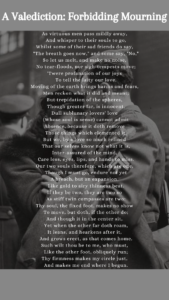Introduction to the Poem:
“A Valediction: Forbidding Mourning” poem was written by John Donne and published in 1633. It is included in Donne’s collection of poems titled “Songs and Sonnets,” which was published posthumously.
In “A Valediction: Forbidding Mourning,” John Donne expresses the idea that true love transcends physical separation. The poem opens with the speaker reassuring his lover that their parting should not be mourned, as their love is not dependent on physical proximity. He compares their love to a compass and a fixed foot, suggesting their connection is spiritual and stable.

John Donne is believed to have written the poem “A Valediction: Forbidding Mourning” for his wife, Anne Donne. This poem, along with others in Donne’s collection of love poems, reflects his deep affection and admiration for his wife. The poem celebrates the strength and endurance of their love, even in the face of physical separation. While Donne’s personal life and relationships are not extensively documented, it is widely accepted that many of his love poems, including “A Valediction: Forbidding Mourning,” were inspired by his relationship with Anne.
About the Poet:
John Donne (1572-1631) was an English poet, preacher, and metaphysical poet renowned for his complex and intellectually stimulating verse. Born into a Roman Catholic family during a time of religious turmoil in England, Donne later converted to Anglicanism and became a prominent figure in the Church of England.
Donne’s poetry is characterized by its intricate use of metaphysical conceits, elaborate metaphors, and intellectual exploration of themes such as love, death, and spirituality. John Donne’s poems work often reflect his personal experiences, including his faith, love, and mortality struggles.
One of Donne’s most famous works is his collection of love poems, which includes “The Good-Morrow,” “A Valediction: Forbidding Mourning,” and “The Flea.” These poems are renowned for their exploration of the complexities of romantic love and their use of elaborate conceits to convey deep emotional and philosophical insights.
In addition to his poetry, Donne also wrote several sermons and religious treatises. His sermons are noted for their powerful rhetoric and profound theological insights, and they continue to be studied and admired for their literary and intellectual merit.
Overall, John Donne is recognized as one of the most important poets of the English Renaissance, and his work continues to be studied and appreciated for its intellectual depth, emotional richness, and linguistic virtuosity. His exploration of complex themes and his innovative use of language have cemented his reputation as a master poet and a significant figure in English literary history.
Summary of the poem:
In “A Valediction: Forbidding Mourning,” John Donne expresses the idea that true love transcends physical separation. The poem opens with the speaker reassuring his lover that their parting should not be mourned, as their love is not dependent on physical proximity. He compares their love to a compass and a fixed foot, suggesting their connection is spiritual and stable.
The speaker urges his lover not to cry or lament their separation, as their love is eternal and unaffected by distance. He likens their bond to gold threads woven into the fabric of the universe, emphasizing its enduring nature.
The poem concludes with the speaker encouraging his lover to bid farewell gracefully, knowing that their love will endure despite their physical separation. He compares their parting to the quiet passing of virtuous men and emphasizes the constancy of their love, likening it to the steadfastness of the North Star.
Rhyme Scheme and Pattern:
The poem “A Valediction: Forbidding Mourning” by John Donne follows a distinct rhyme scheme and pattern. It comprises nine four-line stanzas, known as quatrains, with a consistent rhyme scheme throughout. The rhyme scheme of each stanza is ABAB, meaning that the first and third lines rhyme with each other, as do the second and fourth lines. This consistent rhyme scheme contributes to the poem’s rhythmic flow and musicality. Additionally, Donne employs iambic tetrameter, a metrical pattern consisting of four iambs (or metrical feet) per line, which further enhances the poem’s rhythmic structure
Conclusion:
Overall, ” A Valediction: Forbidding Mourning delves into the concept of enduring love and highlights the notion that genuine love remains unaffected by physical distance or temporary separation.
